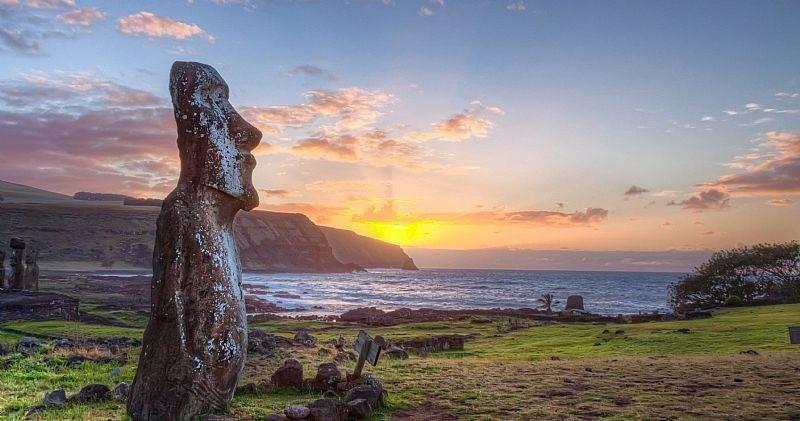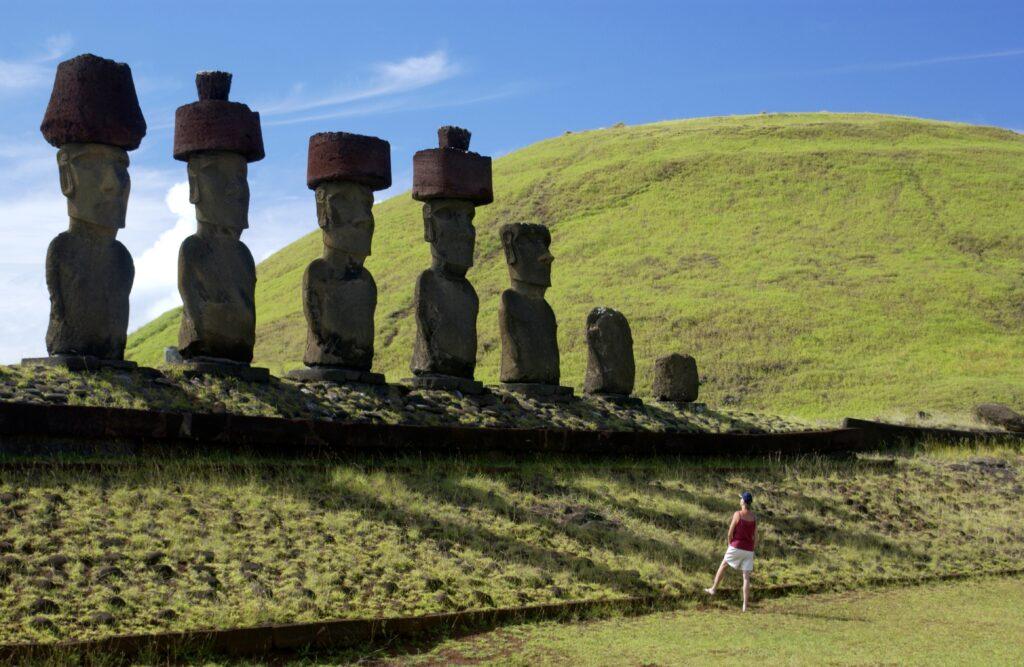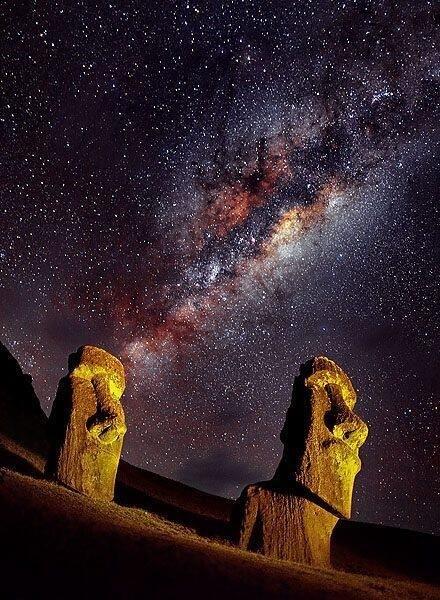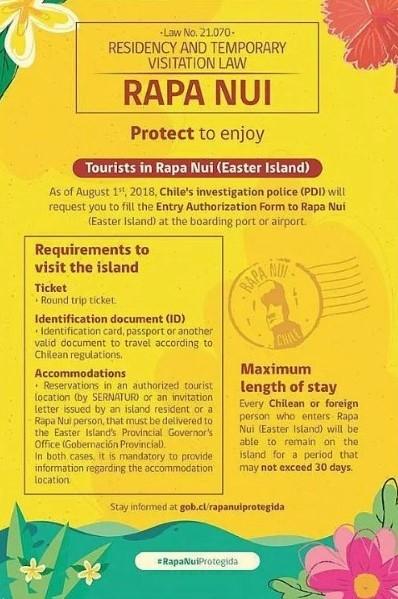The mystery in Rapa Nui or Easter Island is bigger than we thought! Although it is a small island, with 25 km from one end to the other. It is considered the furthest inhabited island from a continent and the most remote on the planet. It is located in the middle of the South Pacific Ocean, almost 4 thousand kilometers from Chile and the same from Polynesia. The closest neighbors live on the Pitcairn Islands, more than 2,000 km to the west. South America is more than 3,500 km to the east, today, at a distance of a flight of approximately five hours.
The first mystery of Rapa Nui
The first mystery of Rapa Nui or Easter Island is the origin of its inhabitants. After knowing its geography, you will have no doubt that it remains a mystery. It is almost mandatory to ask yourself, who were the first human beings to arrive on the island? And above all, how did they reach it? There are several theories that try to solve this mystery about the origin of society on the island.
Polynesian Origin
The most widespread theories are associated with the geographical area of origin, being three specific places: Polynesia, America and Atlantis. The Polynesian theory, the most popular, says that the first Rapanui originated from the Marquesas Islands, located 3,600 km away. Legend has it that King Hotu Matu’a dreamed that his lands would soon be submerged under the sea. So he sent 7 explorers, who found an empty and fertile island. Six of them returned with the good news to the king, who decided to populate the island, to which they named “Te pito o te henua”, translated as “The center of the world.”
American Origin
Secondly, the theory of American origin arises in 1820, with William Ellis being its main defender. This theory suggests that the inhabitants of Rapa Nui, or as it is known after its colonization, Easter Island, would originate from the American continent. They would have arrived on incipient boats, pushed by favorable winds.
In 1948, the Norwegian explorer, Thor Heyerdahl, supports this theory. Indicating that the settlers arrived from Peru, given the similarities of the cultures: stone work, presence of South American plants, sculptures. For which he embarked on a wooden raft to cross the ocean from Peru to Rapa Nui.
Atlantis´ survivors
The third theory, according to the French explorer Dumont d’Urville, the inhabitants of the island would have arrived on foot. As survivors of Atlantis, the great continent, today disappeared under the ocean, which was connected to the Rapa Nui Island.
However, it is still one of the mysteries of Rapa Nui Island. Some support the extraterrestrial theory as a way to explain the origin of its inhabitants. As well as the construction of its famous stone sculptures or Moais.
The giant statues, the best-known mystery of Rapa Nui
The second mystery of Rapa Nui or Easter Island is perhaps the reason why this island is most famous: Moais are gigantic stone sculptures that weigh several tons. Their sizes can vary between 2.5 and 9 meters in height. Its average weight is close to 14 tons, although the largest can weigh up to 80 tons. Becoming true emblems of the island.

Known colloquially as “the giant heads of Easter Island”, the monolithic statues of Rapa Nui evoke the human form. Thanks to the Rapanui oral tradition, it is known that the moai did not represent gods or mythical figures, but important ancestors. The Rapanui people carved hundreds of moai as a way of paying tribute to their ancestors.
Carving of the Stone Giants
One of the many mysteries of Rapa Nui is why they decided to build the Moai in the Rano Rakaru volcano. The stone from this crater served as material for sculpting almost all the Rapanui giants. First the moai was outlined in the rock and then carved, leaving a keel on its back to keep it attached to the bedrock.
With the passage of time the production of the moai became more complex. They increased in height and details and ornaments were also added. In the eye cavities they used to place coral plates, as eyes, and they also wore some tufts or bows on their heads.

The most recurrent is a kind of cap made with a red stone. Known by the name of pukao, the so-called moai hat is yet another mystery of the Rapanui culture. While most of the moai were sculpted in the Rano Raraku quarry, the pukao were produced with the red stone of the Puna Pau volcano, at the opposite end of the Island.
Transportation of the Moai
About the transport and the making of the statues, there is greater ignorance. Approximately 1,000 moai rest on the island, wrapping it in tons of mystery. It is estimated that the production of moai proliferated between the years 500 and 1500 of the common era, but no one knows exactly in which period the statues originated, nor who was in charge of producing them.
There are several theories for the transport of the Moais, which, like the Egyptian pyramids, it is believed that the Rapanui used ropes and ‘choreographed’ movements to move the statues around the island. Likewise, the possibility of helping themselves with platforms similar to sleds (made with tree trunks) has been discussed.
Thor Heyerdhal, enunciated the dragging theory, says that the Moai was placed on its back on a wooden sled and dragged. However, in the 80s, the hypothesis was raised that the Moai actually moved “walking”. He claimed that the standing statue is stable because its center of gravity is low, so it leans to the side and sways forward.
On the other hand, more recent studies suggest that they would have used complex machines on the island for centuries, due to a system of roads that were excavated, where they are supposed to have been used to transport the giant statues. Some of these roads were originally dug into the island’s bedrock, consisting mainly of volcanic rock of a type known as ‘pahoehoe’.
What do the Moai point out? Does its location have a reason?

The third mystery of Rapa Nui or Easter Island lies beyond how the Moai were built, it also accompanies why. Easter Island has no freshwater sources on the island, so it remains a mystery how its ancient inhabitants survived.
A study suggests that they are ceremonial statues that were placed at strategic points where drinking water was found. This conclusion was reached because in places where there are no moai there is no fresh water either, and in places where there are moai there are sources close to drinking water.
When the Europeans first arrived on Rapa Nui, they were surprised to see the indigenous people drinking directly from the sea. Along with the island’s famous moai, this quirk of nature was added to the local list of mysteries.
Recent studies show that rainwater on Rapa Nui pours directly through porous bedrock into an underground aquifer (a body of porous rock or sediment where water is concentrated). These then emerge along the coast as something known as “coastal seeps”, that is, pockets of fresh water that seep into the ocean.
Anthropologists found that, in addition to collecting freshwater from coastal seepage pockets, Rapa Nui people built underwater dams in the ocean to keep freshwater and seawater separate. They built wells, with which they redirected the water from the aquifer before reaching the sea.
Modern mysteries of Rapa Nui
The fourth mystery of Rapa Nui or Easter Island is the one that gave medicine a before and after, since it is still saving lives. It all started when a scientist was amazed to see that the inhabitants of that territory did not suffer from tetanus, despite the fact that they walked barefoot in a land full of horses, the ideal conditions to become infected.
That is why the microbiologist, Georges Nógrády, divided the island into 67 plots and took soil samples from each one. In order to isolate microorganisms from the soil and then analyze the substances they produced.
One of these microorganisms is the bacterium Streptomyces hygroscopicus, with which he produced a compound. In 1972, the isolated product was called rapamycin, in honor of Rapa Nui. Which showed that it was very good at inhibiting the growth of fungi, but also, it was immunosuppressive. That is, it could make you sensitive to other types of infections.
It is a bit selfish to summarize all the clinical studies in one paragraph, because it has delved into the mechanisms of action of the drug. But we can affirm that the uses of rapamycin continue to multiply, as an immunosuppressant and in different types of cancer. Currently, there are dozens of studies to determine its anti-aging potential and its ability to reduce the negative consequences of old age.
Tourism in Rapa Nui

Perhaps this is the only point that is not a mystery, being today their main source of income, the Rapanui, they are jealous of their culture and all the mystery that surrounds the Moai. Most of the island’s inhabitants speak: Spanish, English and Rapanui. The latter shares its name with the island and the people who have inhabited it for hundreds of years.
Since 2018, the Rapa Nui Protection Law came into force, which establishes the entry requirements for tourists, as a way to protect its ecosystem, already quite vulnerable, due to its small size and extreme isolation.
Mataveri International Airport is the only gateway to Rapa Nui. It receives direct flights from Santiago de Chile and Papeete, capital of French Polynesia.
It is increasingly common to travel by private jets to Rapa Nui. Motivated by its geographical location and the size of the island, tourists who visit it often use medium or large private planes (midsize or heavy jet), since the inability to refuel on the island requires planes with great autonomy.
Renting an aircraft with capacity for 8 passengers can cost between USD 80,000 and 100,000, round trip. Prices are subject to aircraft capacity: range, number of seats, year of manufacture and restoration. Request your quote and fly by private jet to this enigmatic destination.